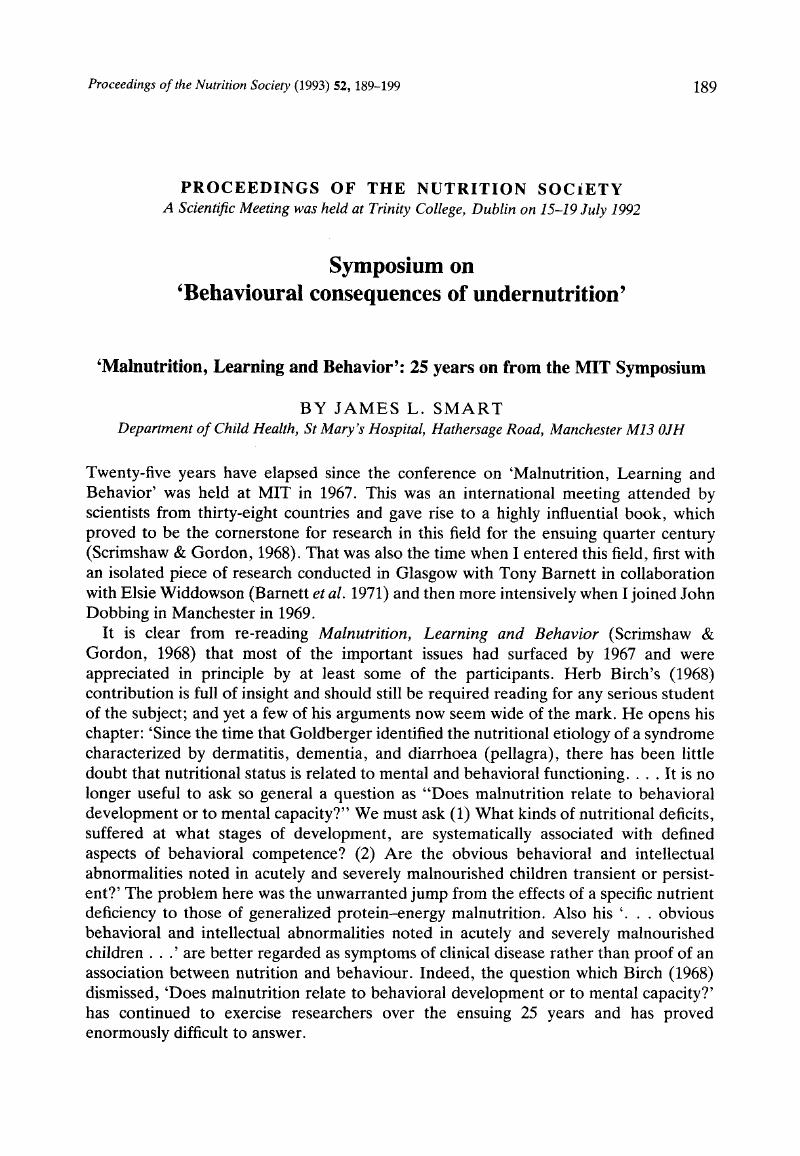Crossref Citations
This article has been cited by the following publications. This list is generated based on data provided by Crossref.
Rogers, Peter J.
and
Lloyd, Helen M.
1994.
Nutrition and mental performance.
Proceedings of the Nutrition Society,
Vol. 53,
Issue. 2,
p.
443.
Wachs, Theodore D.
1995.
Relation of Mild-to-Moderate Malnutrition to Human Development: Correlational Studies.
The Journal of Nutrition,
Vol. 125,
Issue. ,
p.
2245S.
Desai, Mina
Crowther, Nigel J.
Lucas, Alan
and
Nicholas Hales, C.
1996.
Organ-selective growth in the offspring of protein-restricted mothers.
British Journal of Nutrition,
Vol. 76,
Issue. 4,
p.
591.
Rogers, Peter J.
1996.
Food Choice, Acceptance and Consumption.
p.
319.
ALMEIDA, SEBASTIÃO S.
TONKISS, JOHN
and
GALLER, JANINA R.
1996.
Malnutrition and Reactivity to Drugs Acting in the Central Nervous System.
Neuroscience & Biobehavioral Reviews,
Vol. 20,
Issue. 3,
p.
389.
Samson‐Fang, Lisa J
and
Stevenson, Richard D
2000.
Identification of malnutrition in children with cerebral palsy: poor performance of weight‐for‐height centiles.
Developmental Medicine & Child Neurology,
Vol. 42,
Issue. 3,
p.
162.
da Silva, V.A.
da Silva, J.B.
Gismondi, R.A.O.C.
and
Rebello, G.P.
2000.
Ethanol Improves Lactation Outcome in Malnourished Rats.
Nutritional Neuroscience,
Vol. 3,
Issue. 4,
p.
277.
Samson-Fang, Lisa
Fung, Ellen
Stallings, Virginia A.
Conaway, Mark
Worley, Gordon
Rosenbaum, Peter
Calvert, Randy
O'Donnell, Maureen
Henderson, Richard C.
Chumlea, W.Cameron
Liptak, Gregory S.
and
Stevenson, Richard D.
2002.
Relationship of nutritional status to health and societal participation in children with cerebral palsy.
The Journal of Pediatrics,
Vol. 141,
Issue. 5,
p.
637.
Das, Undurti N.
2002.
A Perinatal Strategy For Preventing Adult Disease: The Role Of Long-Chain Polyunsaturated Fatty Acids.
p.
113.
Morgane, Peter J
Mokler, David J
and
Galler, Janina R
2002.
Effects of prenatal protein malnutrition on the hippocampal formation.
Neuroscience & Biobehavioral Reviews,
Vol. 26,
Issue. 4,
p.
471.
Samson‐Fang, Lisa
Butler, Charlene
and
O'Donnell, Maureen
2003.
Effects of gastrostomy feeding in children with cerebral palsy: an AACPDM evidence report*.
Developmental Medicine & Child Neurology,
Vol. 45,
Issue. 6,
p.
415.
O’Connor, Deborah L.
Merko, Susan
and
Brennan, Joan
2004.
Human Milk Feeding of Very Low Birth Weight Infants During Initial Hospitalization and After Discharge.
Nutrition Today,
Vol. 39,
Issue. 3,
p.
102.
Desai, Mina
Gayle, Dave
Babu, Jooby
and
Ross, Michael G.
2005.
Permanent reduction in heart and kidney organ growth in offspring of undernourished rat dams.
American Journal of Obstetrics and Gynecology,
Vol. 193,
Issue. 3,
p.
1224.
Fisher, Michael O
Nager, Ruedi G
Monaghan, Pat
and
DeVoogd, Timothy
2006.
Compensatory Growth Impairs Adult Cognitive Performance.
PLoS Biology,
Vol. 4,
Issue. 8,
p.
e251.
Das, Undurti
2006.
Dietary Fats and Risk of Chronic Disease.
p.
205.
Feeley, Brian T.
Gollapudi, Kiran
and
Otsuka, Norman Y.
2007.
Body mass index in ambulatory cerebral palsy patients.
Journal of Pediatric Orthopaedics B,
Vol. 16,
Issue. 3,
p.
165.
Kuperminc, Michelle N.
and
Stevenson, Richard D.
2008.
Growth and nutrition disorders in children with cerebral palsy.
Developmental Disabilities Research Reviews,
Vol. 14,
Issue. 2,
p.
137.
Belfort, Mandy B.
Rifas-Shiman, Sheryl L.
Rich-Edwards, Janet W.
Kleinman, Ken P.
Oken, Emily
and
Gillman, Matthew W.
2008.
Infant Growth and Child Cognition at 3 Years of Age.
Pediatrics,
Vol. 122,
Issue. 3,
p.
e689.
Soylu, Ozlem Bekem
Unalp, Aycan
Uran, Nedret
Dizdarer, Gülsen
Ozgonul, Figen Oksel
Conku, Aliye
Ataman, Hamide
and
Ozturk, Aysel Aydogan
2008.
Effect of Nutritional Support in Children With Spastic Quadriplegia.
Pediatric Neurology,
Vol. 39,
Issue. 5,
p.
330.
Burns, James G.
Saravanan, Arthy
and
Helen Rodd, F.
2009.
Rearing Environment Affects the Brain Size of Guppies: Lab‐Reared Guppies have Smaller Brains than Wild‐Caught Guppies.
Ethology,
Vol. 115,
Issue. 2,
p.
122.





